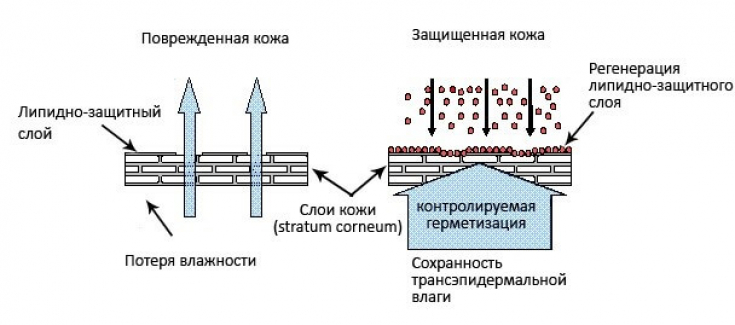Skin is the largest organ of the body and provides general protection from the environment. Practitioners and patients alike recognize that the environment affects our skin and therefore environmental changes, such as the changing seasons, require us to adjust our skin care routines to maintain healthy skin.
Furthermore, as most estheticians know, many skin conditions such as eczema, psoriasis, acne, rosacea and melasma can escalate seasonally, so it is important to consider weather changes when xxxx>treatment planning.
On estet-portal.com read how the skin changes during the year, and how the tactics of caring for her, as well as methods of treating dermatological diseases, depend on these changes.
- Skin changes due to the seasons
- How the skin condition changes in the warm season
- Warm season skincare tips
- Cold season: how to protect your skiny
Skin changes due to the seasons
A recent study published in the British Journal of Dermatology shows that the barrier function of the skin is different in summer and winter. The study found that the amount of natural moisturizing factors that act on exposed skin, the texture of corneocytes, and the breakdown of the protein filaggrin, which supports barrier function of the skin.
It is well known that sebum production increases during the hot summer months, as does the appearance of pigmentary changes.
Transepidermal water loss is significantly lower in summer, resulting in increased hydration levels. Also, the content of many lipids present in the stratum corneum is higher in summer than in winterth.
Skin hydration: a commercial move or a pledge of youth
How the skin condition changes in the warm season
It has long been known about the harmful effects of ultraviolet radiation on the skin, but there is also a positive effect from this effect – vitamin D synthesis.
Vitamin D is synthesized in the body from cholesterol when the skin is directly exposed to ultraviolet radiation.
During the winter months, there is not enough ultraviolet radiation for our body to synthesize this important prohormone. Therefore, to activate vitamin D synthesis, it is recommended to expose exposed skin (without the use of SPF products) to sunlight for short periods of time between 11:00 and 15:00.

The relationship between skin and vitamin D is not limited to its synthesis. Vitamin D plays a vital role in the barrier and immune functions of the skin, participating in cell differentiation and proliferation, as well as the function of the sebaceous glands and hair follicles.
In addition, vitamin D deficiency has been linked to a host of skin conditions such as psoriasis, acne, and even skin cancer.
From a cosmetic point of view, during the warm season, patients undergoing procedures such as chemical peels, laser or plasma treatments are more at risk of post-inflammatory hyperpigmentation. Heat can also stimulate the sebaceous glands, causing them to secrete more sebum, which, when mixed with sweat, will give the face a greasy sheen.
Skin conditions that are "disliked" by sun:
- During the summer months, melasma worsens as UV radiation and heat stimulate melanocytes. It is important to inform patients about this.
In patients with acne, the skin condition may worsen as a result of increased sebum production.
- Excessive heat and humidity can exacerbate fungal infections such as impetigo, athlete's foot.
- Rosacea also tends to flare up in summer due to UV radiation being an important trigger for this disease.
However, the condition of the skin with eczema and psoriasis improves in summer withi.
Read the most interesting articles in Telegram!
Skin care tips for warm seasons
It is best for the aesthetic practitioner in the summer to avoid aggressive regimens for patients who have not previously taken strong retinol preparations unless they are committed and will comply with sun exposure conditions and finicky use of SPF.
In the summer, it is best to advise patients to use a good cleanser to control sebum, as well as products with antioxidants that scavenge free radicals produced by UV radiation. It is also very important to use quality products with a high SPF.
For patients with oily, acne-prone skin in summer, recommend exfoliators and products with salicylic acid.
In summer it is better to avoid aggressive peels and laser treatments. A popular peel in the warm season is the mandelic acid peel which is less aggressive. It is especially beneficial for rosacea sufferers as it is less irritating to the skin than other alpha hydroxy acids and has antimicrobial propertiesand.
Express Skin Care Treatments: An Effective Combination of Treatments
Cold season: how to protect your skin
In winter, the rapid change in temperature, from warm indoors to cold outside, can affect the capillaries, causing them to rapidly expand and contract, resulting in redness and telangiectasias.
Cold air increases transepidermal water loss, and wind reduces the amount of lipids on the skin needed to maintain the barrier function of the skin.

The cold months are a time for increased hydration of the skin and the use of products that regulate the skin's natural hydration, supporting the epidermis and restoring barrier functions. Products containing ceramides and hyaluronic acid are great for boosting hydration.
Winter is the perfect time to reverse the damage done in summer. Cooler temperatures and less intense ultraviolet radiation reduce the risk of procedure complications. Therefore, this is the ideal time for more aggressive approaches in cosmetics.
It is also important to be mindful of the effects of the sun on the skin in winter and use sunscreen.
Temperature, humidity and UV radiation vary seasonally. And as the largest organ, the skin is affected by these changes. However, by understanding the skin physiology, we can prepare for weather variability and minimize the damage that each change of season causes.
Read also: Proper hand care







Add a comment